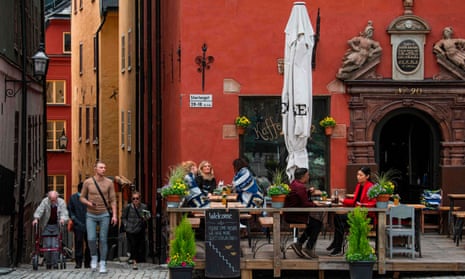Sweden’s chief epidemiologist and the architect of its light-touch approach to the coronavirus has acknowledged that the country has had too many deaths from Covid-19 and should have done more to curb the spread of the virus.
Anders Tegnell, who has previously criticised other countries’ strict lockdowns as not sustainable in the long run, told Swedish Radio on Wednesday that there was “quite obviously a potential for improvement in what we have done” in Sweden.
Asked whether too many people in Sweden had died, he replied: “Yes, absolutely,” adding that the country would “have to consider in the future whether there was a way of preventing” such a high toll.

Sweden’s death rate per capita was the highest in the world over the seven days to 2 June, figures suggest. This week the government bowed to mounting opposition pressure and promised to set up a commission to look into its Covid-19 strategy.
“If we were to encounter the same disease again knowing exactly what we know about it today, I think we would settle on doing something in between what Sweden did and what the rest of the world has done,” Tegnell said. It would be “good to know exactly what to shut down to curb the spread of infection better”, he added.
In an interview with the Dagens Nyheter daily, Tegnell subsequently said he still believed “the basic strategy has worked well. I do not see what we would have done completely differently … Based on the knowledge we had then, we feel we made the appropriate decisions.”
According to the scientific online publication Ourworldindata.com, the number of Covid-19 deaths per capita in Sweden was the highest in the world in a rolling seven-day average to 2 June. The country’s rate of 5.29 deaths per million inhabitants a day was well above the UK’s 4.48.
The Swedish prime minister, Stefan Löfven, told the Aftonbladet daily that the country’s overall approach “has been right”, but it had failed to protect care homes where half of all Sweden’s Covid-19 deaths have occurred. Social affairs minister Lena Hallengren told Reuters the government had been “at all times prepared to introduce wider, further measures recommended by the expert authority”.
Relying on its citizens’ sense of civic duty, Sweden closed schools for all over-16s and banned gatherings of more than 50, but only asked – rather than ordered – people to avoid non-essential travel and not to go out if they were elderly or ill. Shops, restaurants and gyms have remained open.
Although there are signs that public opinion is starting to shift, polls have shown a considerable majority of Swedes support and have generally complied with the government’s less coercive strategy, which is in stark contrast to the mandatory lockdowns imposed by many countries, including Sweden’s Nordic neighbours.
But the policy, which Tegnell has said was aimed not at achieving herd immunity but at slowing the spread of the virus enough for health services to cope, has been increasingly and heavily criticised by many Swedish experts as the country’s death toll has increased.
Sweden’s 4,468 fatalities from Covid-19 represent a death toll of 449 per million inhabitants, compared with 45 in Norway, 100 in Denmark and 58 in Finland. Its per-million tally remains lower than the corresponding figures of 555, 581 and 593 in Italy, Spain and the UK respectively.
Norway and Denmark announced last week that they were dropping mutual border controls but would provisionally exclude Sweden from a Nordic “travel bubble” because of its much higher coronavirus infection rate.
Tegnell told Swedish Radio it was not clear yet exactly what the country should have done differently, or whether the restrictions it did impose should have been introduced simultaneously rather than step by step.
“Other countries started with a lot of measures all at once. The problem with that is that you don’t really know which of the measures you have taken is most effective,” he said, adding that conclusions would have to be drawn about “what else, besides what we did, you could do without imposing a total shutdown.”
Annike Linde, Tegnell’s predecessor as chief epidemiologist from 2005 to 2013, said last week that she had initially backed the country’s strategy but had begun to reassess her view as the virus swept through the elderly population.
“There was no strategy at all for the elderly, I now understand,” Linde told the Swedish state broadcaster. “I do not understand how they can stand and say the level of preparedness was good, when in fact it was lousy.”
She said another key mistake was to assume that the coronavirus would behave like seasonal flu. “It does not behave like the flu at all,” she said. “It spreads more slowly and has a longer incubation time. This makes it more difficult to detect, and to build immunity in the population.”
A study last month found that only 7.3% of Stockholm’s inhabitants had developed Covid-19 antibodies by the end of April.
